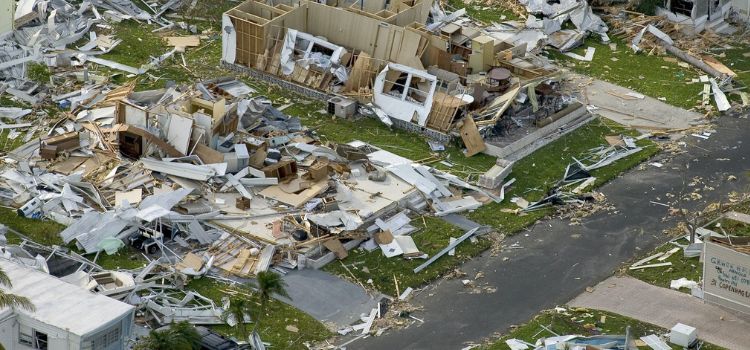The impact of hurricanes has always been devastating to people who live in the west. Since she was created, the hurricane has been one of the deadliest natural disasters in the United States.
Contents
They often make devastating landfalls, completely disrupting life and leaving thousands of people homeless and in need.
But how do they end?
The dissipation of a hurricane
When a hurricane becomes extinct, it is usually due to various factors, including the strength of upper-level winds, friction with landmasses, and competition with another tropical system.
These factors all contribute to the dissipation of the hurricane. The factors that influence the excess of a hurricane are discussed in this article. But some factors cannot be ignored.
Hurricanes are driven by heat energy from warm surface waters of the ocean. Warm water vaporizes faster than cool water, allowing warmer air to rise. Warm air also cools, making the storm’s air density lower.
As warm air rises, it condenses, releasing more heat. The moist air condenses, turning into clouds, which release more heat. Ultimately, the hurricane begins to degrade and becomes a weak extra-tropical cyclone.
Another reason for the dissipation of a hurricane is when one of its essential driving factors weakens. When the storm reaches land, it loses its warm water source and its ability to recharge itself.
If the hurricane encounters cool waters or a large area of strong vertical winds, the wind shear and eye mechanism may break up, causing the hurricane to dissipate.
The Stages Of A Hurricane
Hurricanes develop in four stages, from tropical disturbances to a full-fledged storms. Tropical disturbances are formed when the oceans in a tropical region become warm enough to cause storms.
These storms start out as a mass of thunderstorms with small wind circulations. Then, when thunderstorm activity occurs in the area, this warm water transforms into hurricane fuel. Hurricanes usually appear on the western coast of North America, the Caribbean, St. Thomas, and Madagascar.
While tropical storms are smaller versions of hurricanes, they can cause significant flooding. They have wind speeds of 39-73 mph, and they look like miniature hurricanes. If the hurricane’s wind speed reaches 74 mph, it’s an actual hurricane.
Once the eye forms, it’s called a hurricane (learn why the eye of the storm is so dangerous). As hurricanes grow, they begin to execute turns in their path. If you have a phone or a computer, you can sign up for Tangi Alerts, an emergency notification program. This program will send you messages through your preferred contact methods.
Tropical depressions are the first stages of a hurricane. These storms are formed when a tropical disturbance is a storm. At this point, it looks like a cluster of thunderstorms on satellite images.
If the winds are under 38 mph, it will remain a tropical depression. Once it gets over 38 mph, it can become a hurricane. The storm retains its hurricane-like spiral shape, but its winds are below 73 mph.
Despite the low-level wind speeds, tropical depressions do not cause significant damage and are often the most common category 1 storms in the Atlantic Ocean.
Disturbance Formation
When it comes to tropical cyclones, you can divide them into four stages: Tropical depression, subtropical cyclone, and full-blown hurricane. All these stages occur in the same way: warm ocean water evaporates and releases heat into the atmosphere.
This warm moist air rises, condensing as clouds. It also releases heat into the air, warming and cooling it simultaneously. This warm moist air feeds the hurricane, creating strong updrafts that pull more air into the center.
When the tropical storm moves over land, it begins to lose its strength, but it can still bring significant rain. In addition to the slow decline, the storm is likely to be weakened by dry air, which is present in the Saharan Air Layer.
However, the importance of this layer in hurricane development is still debated. In either case, a hurricane may lose its strength before reaching land. In addition, it can be affected by dry air from the Saharan desert.
Tropical Disturbance
Hurricanes start by moving north, then eastward around Bermuda. As they move northward, the ocean’s warm surface water condenses and releases heat into the atmosphere.
The warm air rises, and warm air cools as it condenses as clouds. Moisture condenses, releasing heat; the resulting condensation cools the air and releases more. The warm surface water fuels the hurricane and creates stronger updrafts, which pull in more air.
A tropical cyclone’s path is outlined in red arrows. The small ones show warm, moist air rising from the ocean surface. Large arrows indicate a rotation of bands of cloudy air.
As the storm moves eastward, its center will move closer to the Florida coast and the Gulf of Mexico. Once this occurs, the hurricane will die. However, the storm may continue to move eastward.
Scientists use esoteric terminology to describe the development of a hurricane. Hurricanes are classified into different categories based on the wind speeds they can reach. These are based on the maximum sustained winds and one-minute average wind speed in the interior of the storm.
Tropical cyclones begin as a storm complex off Africa, developing into a hurricane. Then, the storm develops into a tropical depression if it meets specific criteria.
Tropical Depression
Before a hurricane can become a tropical depression, it must reach a certain intensity threshold. A tropical depression can grow from a tropical storm into a hurricane if certain conditions are met.
The ocean’s temperature is also a key factor, as it helps feed a tropical storm. Eventually, a tropical depression may become a major hurricane. The next step for a tropical depression is to move westward.
A tropical disturbance develops from a cluster of marine clouds that have begun to show signs of organization. The storm may strengthen if the ocean temperature remains warm and the surface winds are low.
Wind speeds above this threshold may be less than 38 miles per hour. A tropical depression, on the other hand, is a hurricane and is classified as one. Its maximum sustained winds are still under 38 mph. During this stage, a tropical hurricane can become a typhoon or a hurricane.
As the wind speed increases, a tropical depression will become a hurricane. To become a tropical storm, a low-pressure area with multiple thunderstorms develops.
These thunderstorms create a circular wind flow. In addition, hurricanes are defined by a wind speed of over 74 miles per hour. Once this threshold is met, a tropical storm can become a hurricane. If the wind speeds are lower than 39 miles per hour, it will be a tropical depression.
Tropical Storm
What is a tropical storm? A tropical storm is a group of thunderstorms that form over warm tropical oceans. They can remain in an area of low atmospheric pressure, rotate, and eventually become tropical cyclone. You can learn more about how hurricanes affect the atmosphere here.
The cyclone is like a giant atmospheric heat engine, powered by the moisture in the warm ocean. Once it reaches a certain height, it becomes a hurricane. A tropical cyclone that produces winds of up to 74 miles per hour is considered a hurricane during its life cycle.
A tropical storm is an organized group of thunderstorms with a cyclonic circulation and maximum sustained winds of between seventeen and 32 m/s. Its wind speeds can reach 36-63 kt (62-117 km/h), and it begins to develop a cyclonic shape.
At this point, it receives a name from the government weather services. Once it passes over a populated area, it begins to weaken and eventually dissipate.
Hurricane
When a hurricane makes landfall, it begins to weaken. This is due to the increased roughness of the land surface, which reduces the surface circulation. As the hurricane approaches land, it begins to weaken and break into thunderstorms. However, before landfall, it can cause extensive damage and destruction.
In these situations, scientists use a computer model to determine the strength and intensity of the hurricane. This model considers several factors, including the speed of the hurricane’s winds, the distance it covers the ocean, and the shape of the coastline and seafloor.
In certain situations, a hurricane can weaken by encountering dry air from the Saharan Air Layer. This dry air is a source of fuel for the hurricane but also weakens the storm’s structure. Experts are still unsure of the exact role of this air layer, but it is likely to weaken the hurricane. When this happens, a storm can develop into an extratropical cyclone.
Dissipation
Three main components of a hurricane’s power affect its risk potential: intensity, frequency, and duration. Hurricane intensity changes with landfall, while decay rate changes with time.
For category 4-5 hurricanes, the relationship between post-landfall wind speed and the decay rate is less specific. Hurricanes that pass over land may weaken further and then rejuvenate. Here’s what you need to know about hurricanes’ power and decay.
Hurricanes change the landscape, uprooting trees with powerful winds. Their water forces are powerful enough to move the earth. Hurricane Agnes rearranged the hydrology of the Chesapeake Bay area, eroding the mouths of tributaries and transporting massive amounts of sediment upstream.
Hurricanes can also create new islands by accumulating coral skeletons. And in some cases, entire reef blocks are displaced and deposited on shallow nearshore waters.
One of the most essential factors in determining the intensity of a hurricane is the balance between energy production and dissipation. Various models attempt to simulate hurricane intensity by solving complex equations.
This method, however, introduces additional dissipation. The results of numerical dissipation are often inaccurate, mainly when they differ from the measurements from airborne Doppler radars in hurricane RI.
Where do hurricanes end?
Hurricanes do end but almost never in the location where most hurricanes begin — they usually begin in the Carribean and go through the Gulf of Mexico before making land fall along the U.S. East Coast.
The last hurricane to make landfall in the United States was Wilma in 2005 — the last major hurricane to make landfall was Katrina in 2005. Also, the last hurricane to strike Cuba was Dennis in 2005 — most unusual is the U.S. is last hit by a major hurricane and then Cuba gets the next major storm.

